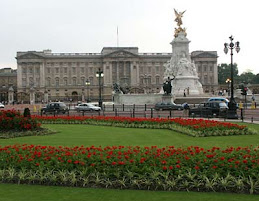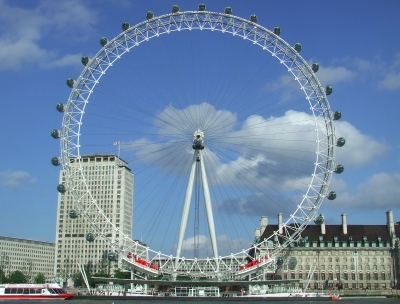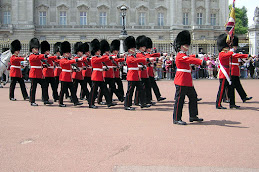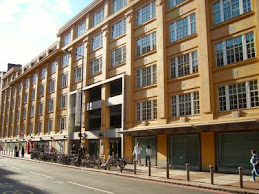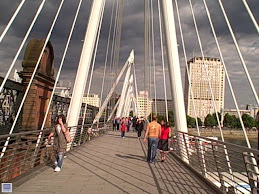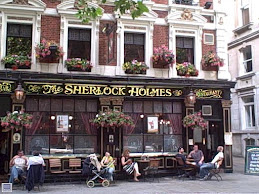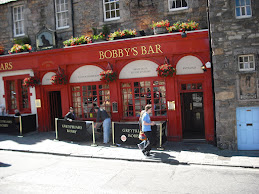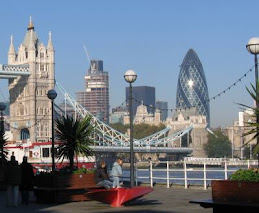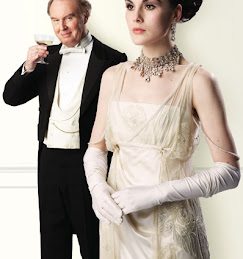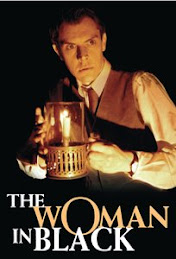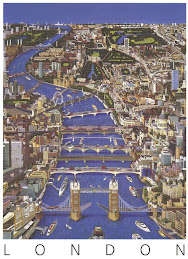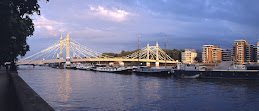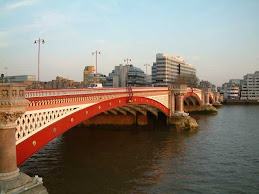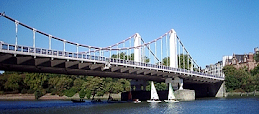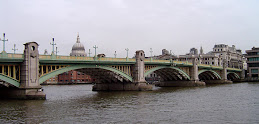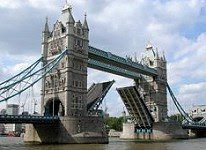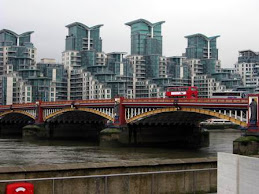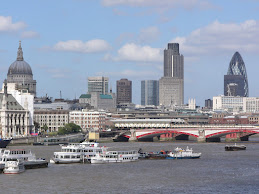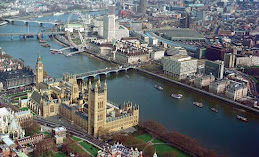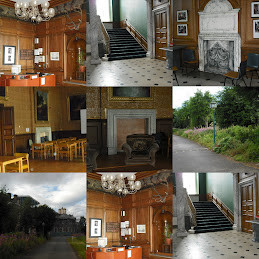
(Outdoor Gardens, Pond and Fountains)
A Beautiful Day to Visit the National Art Library:
The class made a quick trip via the Northern Line to the Jubilee Line and then to the District Line, with a jump off at the South Kensington stop. The National Art Library at the Victoria and Albert Museum was our destination and once there, discovered a beautiful facility, yet it was almost a shame to leave the gorgeous blue skies to be inside for a few hours. We were all very thrilled to take this tour though, and get a taste through a hands on experience and tour through a special presentation of the collection.
The Victoria & Albert Museum and the Tour:
The entrance into the Victoria & Albert (V & A) Museum from the subway or “Tube” as I should more correctly say it in British terminology, was a grand one. The building was fabulously ornate with all of the woodwork, decorative trim and mouldings that just took my breath away. I only hope that my videos I take can capture a part of what I am viewing today to share with my friends, family and others. I am still very disappointed that my camera is broken and I have to reply 100% on my flip video to embellish my blogsite. I just hate the thought of purchasing a camera here in England that equates to over $500. Arrrghhh!!
Welcome Francis Warrell, Assistant Librarian:
Our tour guide was surprisingly a very young librarian who had been employed with the Victoria and Albert Museum for six months. Regardless of her short time there, it was obvious she knew the collection and all there was to know about the library! My only concern was her soft spoken voice and the fact that like myself, not everyone would catch everything she said. I am another individual who has a soft voice, so it is something that I am concerned with at work, as I have to project my voice quite a bit. Because I teach 6 computer classes at the public library presently, I have to turn on that radio personality and pump up the volume. With three hours per class taught, my voice is tested! It is something I have had to learn and comes with working with the public. While I recognize the fact she is a young Librarian and I am not, possibly this may come with age, maturity and experience?? Anyway, I wish she would have turned up the volume and I did not want to be rude and ask her to do so!
A Tour Through the Library: Levels 1, 2, & 3
The National Art Library offers the national collection of documentary art, craft and design and the largest of its type in the United Kingdom. The library offers a research collection that is open for patrons to use as a reference library. Mrs. Warrell quietly lead the class into the Reading Room and warned us to keep as quiet as possible as there were many studying and working. At the other end of the room was a Registration Desk, where we were told that people can register as a patron for up to three years or for one month. She let us know that there are two main public areas, of which we were in one. There is a fairly large special collections base at this library and a staff member can simply collect items for a patron by showing a form of identification. At the Inquiries Desk, a bit further down in the same room, a patron could get assistance and access reference resources, art indexes in digital and book format, and databases of museum objects with the assistance of a staff member here. Francis stated that patrons have access to a copier or “reprographic” for 15 to 20 pence per copy. Photo prints can be obtained from a special printer and are helpful when using large books and journals. Francis said the journals date back to the 1930’s.
Retrieving Items for Patron Use:
Next, we entered a new room that stemmed from a public access area. This zone was for staff purposes only and was used by “Retrieval Staff”. The staff retrieve items and make available each hour and half hour by placing in a designated area that is really a historic holding system for items. The use of the Dewey Decimal System is put into place with this collection to help organize items in the collection. To start the retrieval process, a “Triplicate” form or Slip needed filling out. These slips held up to six items at a time. The slips come through a wooden open shelving area that was a go between the staff area and the public area. This is the historic area of the library I was speaking of that has not changed and still serves an important purpose even today. The staff retrieves the ticket and then the item(s), to placed with the slip upon arrival in the "open hatch" as our tour guide coined it.
Periodical Stacks:
The next room visited was the periodical room, which was a comfortable and cool one. There are over 8,000 titles, with over 2,000 items that are current. Most of them are bound, mostly hard copies used for exhibitions and for curator use. This binding serves a purpose in preservation and keeps the items in good condition. The librarian told us that presently the library is not binding everything due to budgetary constraints, as is a common problem with libraries in the United States. She explained that by keeping some of the periodicals individual, not bound in the typical annual bindings, this actually helped to better show the piece at exhibitions!
Our venture Upstairs:
The upper level of the library was installed in the year 1966, and initially served as a storage space. There were many filing cabinets and cases and per Mrs. Warrell, required the challenge of managing/using a host of keys in locking each unit. The collection stored here offered items dating back to medieval manuscripts of the nineteenth century. We were informed that the arts books are the largest collection in England! Artists such as Mulan and Forester (a great friend of Shakespeare) were revealed in this collection through historical art works. Shakespeare’s folios are also represented! This library also has original proofs of most of Dickens novels!!
Up to the Balcony we Go and What is found in the Collection:
The view from the balcony was a good one that overlooked the three galleries. The collection above was a special collection as it offered items dating back to 1850 of the Great Exhibition. Other items in the collection of over two million items also include: Art & Design; textiles; sculpture, catalogs dating back from 1851 and items from Asia for some examples. The collection was established in 1837 and was earlier stored at the Summerset House. This was the facility across the Waterloo Bridge, north of our dormitory home on Stamford Street. The beautiful Summerset House was the location of a lovely welcome party for the British Studies students by King’s College. Everyone dressed in their finest clothes brought on the trip for the event!
The West Room:
It was in the next room that we entered that we observed and learned that this room was being cleared out for a new space to house 20th century books and artifacts. The aging collection found left on the top shelves are partly the Gilbert collection from the Albert House. The items were mostly grouped by subject, but not so much anymore, as they are stored in what the young librarian called a boiler cabinet(?). Basically a hidden wooden bookshelf with moulding for a door. Below was pointed out a crypt of books as another mode of storage of the ancient collection that is not accessed as often. There are actually two hour runs for these items, but this does not occur very regularly. When asked about preservation of the well used, somewhat tattered ancient items found on the book shelves above, Francis stated that there is less budget to conduct adequate preservation and that students and a conservation department is involved in repairing books.
We were directed to look at the shelving area where staff is allowed to bring home reference materials. This was another behind-the-scenes room where one could find many boxes. Francis discussed what on site access entailed, that of circulation, interlibrary loans and visits. She explained that off site access is what is found in the three boxes found in this room.
Cataloging and Acquisitions:
It was of interest to me to learn that the library had access to quite a bit of money to spend on acquisitions and she said stated, the library must “keep buying to keep the budget up.” All items in the collection are retrievable as each item is catalogued and therefore well organized. The requests for catalogued items are done by a data order.
At the end of this room, we came to an area where there were many boxes that we learned were gifts to the library. We were told about the Exchange Program with other Art museums around the world. Interestingly, the British Library donates to them. Upon reaching this room, posted on the wall was a list of four library values that our teacher Dr. Welsh observed:
• Generous
• Coherent
• Rigorous
• Imaginative
A Steep Climb to the Tippity Top: Floor 3
On the third floor was “the stacks” that housed exhibition catalogs (75%) predominantly, which was considered an expansive collection and dated back to the 18th century. This collection was originally organized by: country; gallery; and year. More recently items, are organized by size, as it appears to be a common theme in the libraries we have toured so far. A large percentage of items cover all languages, yet mostly German and French.
Prints & Drawings Study Room: For Our Eyes Only
The special collection books found in this room were a special display for our viewing on this tour and was meant to highlight very special items in the collection of historical and some of literary significance. The items offer an account of the history of the library and museum. To list some of the wonderful items displayed and allowed to view/touch were:
•Diary with maps/illustrations
•Jonathan Swifts copies of Gulliver’s Travels
•Islamic volumes, only beautiful binding remaining dating from Victorian period
•Sales catalogs
•Sketch books
•David Copper$ proofs (Dickens writings)
•Artists books, made from Rabbit Pelts
•Detroit Book, innocent pink cover with gun as bookmark and reference to body parts within; a book of murder and crime.
Preservation/Conservation:
The preservation room is a separate area where library staff try their best to keep the collection in its present state, yet with budgetary constraints and the size of the collection, this was a daunting task. Mrs. Warrell showed us a conservation box that would be considered the first phase of conservation, where individual items are place within. Depending on the item and its size, placement could be placed in a number of different holders to preserve the item (second phase) such as: dust jackets and ties, envelopes with plastic covers for paper sleeves. There were many letters to be preserved and some were even pasted into a book, yet that is not a practise carried out anymore. It was interesting to see that microfiche was another storage medium that used to be used (1920’s) to store items, but that is not carried out anymore. My favourite item to actually hold and relish was Leonardo Da Vinci’s facsimile of 1 of 3 volumes of notes, that consisted of his writings, diagrams and drawings!
Websites of Interest:
National Art Library at the Victoria & Albert Museum
